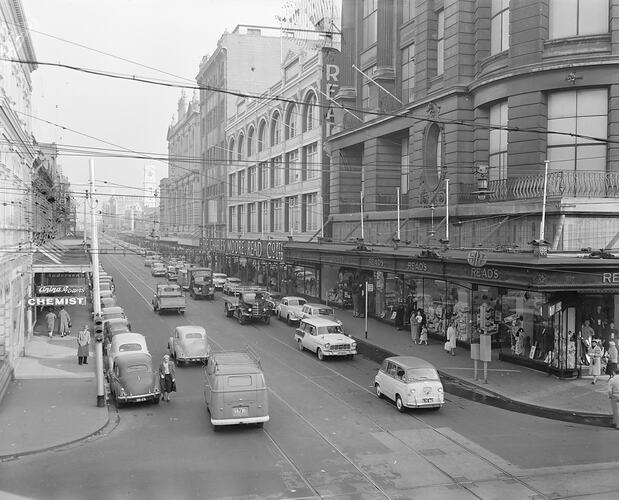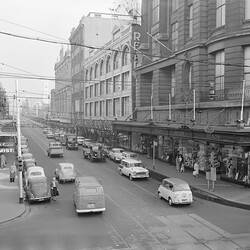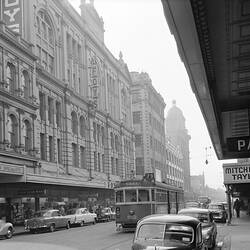The Jam Factory, Prahran site, and The Jam Factory, located on Chapel Street in South Yarra, were used for the production of jam from 1876[1]. Occupied by several preserve manufacturers over approximately the next 90 years, including the iconic 'IXL' brand name. In the early 1970s, the factory site underwent major building works to become a shopping complex.
1876 - Robert Wright and Robert Paine, owners of the Victorian Jam Co., previously based in Fitzroy, bought the Victoria Brewery site in Prahran and altered it for use in the production of jam. The company's name was changed the following year to the Victoria Preserving Co., and by 1880 was known as the Red Cross Preserving Co.[1]
1880 - The company had become the largest employer in the Prahran area, employing 230 people at the peak of yearly production.[1] A large proportion of the factory labourers, 40%, were boys [1]. In Tasmania, the situation may have been similar in jam production, with Henry Jones, later joint owner of Henry Jones Co. and the IXL brand name, having begun his working life as a 12 year old boy in George Peacock's Jam Factory in Hobart [2] and [4].
1883-1893 - Due to financial problems, the Red Cross Preserving Co. is taken over by by Samuel Capper and Co., and canning machinery is brought to the factory. However, the financial problems persisted, and the company stopped trading in 1893. [1]
1895 - William Peacock, of George Peacock and Sons, who had previously been running the Victorian arm of this Tasmanian preserving company, buys the factory. 'George Peacock and Sons' was owned by his son Ernest, Henry Jones and Achalen Palfreyman.[1]
1896-1898 - Under William Peacock, the Wandin Fruit Growers Jam Factory opened at the site, changing its name to the 'OK' Jam Co. in 1898.[1]
1905 - Under Achalen Palfreyman, the Australasian Jam Co. (AJC) began operations in some of the factory, initially alongside the OK Jam Co. In 1905, the OK Jam Co. closed, and the AJC occupied the remainder of the site.[1]
1909 - The Henry Jones Co-operative Co. Ltd. was formed, by which time the company had grown to become international in its scope. A rarity in Australia during the early twentieth century, its interests extend 'to all Australian States, New Zealand and South Africa' [1] and to the Empire's metropolitan hub, London [2]. The sucess of the company was in part buoyed by colonial trade tariffs.[2]
1919 - Henry Jones was knighted. [2]
1926 - Henry Jones died on October 29th in Melbourne. Achalen Palfreyman became the chairman of the company, and moved its Head Office to the Prahran site[1]
1940s-1950s - With the increasing affluence of the post war years, more fresh fruit and less jam was consumed, causing a market downturn.[1] Conflicting information about the treatment of workers and working conditions in the factory is highlighted by historian Sally Wilde, who notes that 'despite various complaints about wages, hours and the hygiene or lack thereof, in the men's toilets, by 1944 AJC in Prahran was being held up as a good example of working conditions by the Department of Labour abnd National Service.' [3]
1965 -1967 - In 1965, Achalen Palfreyman retired as company chairperson, at the age of 90, passing away two years later.
1970s - Jam production ended at the factory in the early 1970s. In 1972, IXL was taken over by Elder's, and plans were drawn up for the alteration of the factory into a shopping complex, which opened in 1979. [1]
References:
No Author, No Date, 'Chronological Development of the Site, Chapel street, South Yarra', found at Stonnning History centre, 'Jam Factory archives box', Room 2, Box 131.
No Author, The Australian Encyclopedia, Volume V: Hospitals to Marsh, (The Grolier Society of Australia, Sydney, 1965), p.143.
Wilde, Sally, The History of Prahran, Volume II 1925-1990, (Melbourne University Press, 1993), pp.155.
'Sudden Death of Sir Henry Jones', The Mercury, Hobart, 30th October, 1926, p.9.
More Information
-
Keywords
-
Authors
-
Article types


